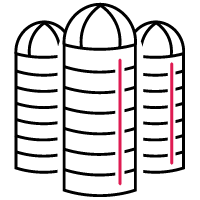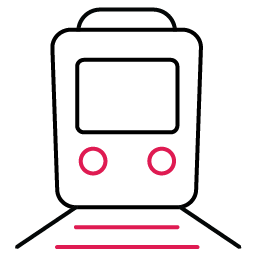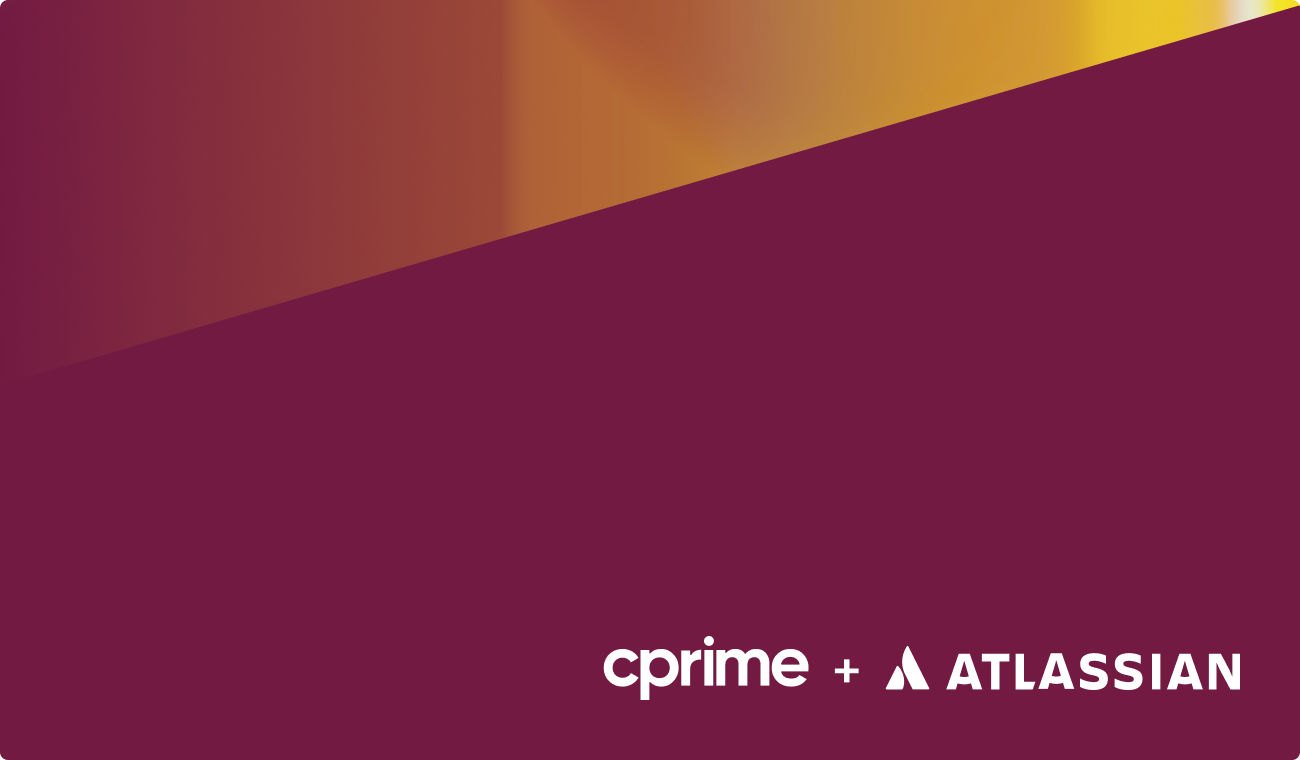The Challenge: Lack of Alignment and Planning Struggles Slowed the Agile Scaling Journey
As they progressed in their efforts to scale their Agile practice, they identified opportunities for improvement across the board, both in processes and in the underlying cultural and strategic approach they were taking to scaled agility.
Interdependent teams working in silos
 “We had four delivery teams working with two products,” says the R&D department’s Product Director, “and the products are highly interdependent. The data coming out of each feed the other in a cycle. So the delivery teams worked hard on their own product backlog items (PBIs) but there really wasn’t a mechanism for keeping all four teams aligned at all times.”
“We had four delivery teams working with two products,” says the R&D department’s Product Director, “and the products are highly interdependent. The data coming out of each feed the other in a cycle. So the delivery teams worked hard on their own product backlog items (PBIs) but there really wasn’t a mechanism for keeping all four teams aligned at all times.”
Additionally, the effectiveness of planning was limited because different teams were planning independently in parallel, which often left risks and dependencies undetected until they became blockers.
Project instead of product mindset
This leading pharmaceutical manufacturer had already engaged Cprime a year earlier to provide extensive training courses around various Agile disciplines and Lean Portfolio Management (LPM). As a result of her own experience in these training classes, the Product Director recognized that the delivery teams were approaching their workflow from a project perspective rather than focusing on value streams, which is a core foundation of SAFe and LPM. To progress with their scaling journey, this would need to change. This core adjustment in what was guiding the work would require tremendous change involving many people. It was no small task.
“We had four delivery teams working with two products and the products are highly interdependent. The data coming out of each feed the other in a cycle. So the delivery teams worked hard on their own product backlog items (PBIs) but there really wasn’t a mechanism for keeping all four teams aligned at all times.” – R&D department’s Product Director
Limited understanding of the big picture
Finally, a general lack of alignment between the business and technical teams resulted in priorities and tasks being set down without the teams really understanding the bigger picture of what they were building and why. This is a situation that we see affecting nearly every organization in one form or another. While it can be a formidable challenge, the delivery teams were eager to overcome it.
The Solution: Bringing in a Release Train Engineer (RTE) to Solidify SAFe
Heading into 2022, they reached out to Cprime to source a coach and SAFe expert who could help guide the teams through the coming changes. Ryan Evans, RTE and Agile Coach, took on this challenging and exciting engagement.
An initial assessment and gap analysis
 “Although I am an RTE,” Ryan says, “running the Agile Release Train (ART) wasn’t my first task. I needed to thoroughly understand where the teams were in terms of Agile maturity and workflow so I could give the ART the best chance at success.”
“Although I am an RTE,” Ryan says, “running the Agile Release Train (ART) wasn’t my first task. I needed to thoroughly understand where the teams were in terms of Agile maturity and workflow so I could give the ART the best chance at success.”
Ryan worked closely with the Product Director to perform a large-scale assessment of the delivery teams and processes. In the end, the assessment functioned as a gap analysis.
“I’ll never forget opening Ryan’s report,” she says, “to see forty-six items listed as opportunities for improvement. But it was great to see everything out on the table. Then, Ryan and I discussed each item and decided which were most important and would have the most impact. Then we could focus our efforts accordingly.”
Ryan adds, “While the gap analysis turned up many necessary improvements, we could boil nearly all down to a few main themes: getting all the teams unified into one ART and working on one cadence so they could plan and execute the work as a cohesive unit, and applying foundational SAFe concepts pragmatically to better organize and prioritize the work being done. So, that’s what we did.”
Changes to enhance PI Planning
Ryan began working with the teams in February 2022, five weeks before the end of the first quarter. With an eye on optimizing the Q2 PI Planning session, he focused on making changes that would get meaningful results without causing undue disruption.
“We had about five weeks to prepare for the new PI Planning,” Ryan recalls, “so it was a blur of activity. We needed to coordinate a much larger and longer session than they’d done before, and we wanted to do some preliminary training so the teams and leadership could get the most out of the event. But we completed it and ran an enhanced planning session involving all four teams, as well as subject matter experts and other stakeholders from several other business units—about one hundred attendees on three continents.”
The primary goals of these changes were:
- Getting on the same page — Bringing all four teams together for a single, all-encompassing planning session
- Getting on the same schedule — Establishing a unified cadence so everyone could effectively plan, deliver, and continually improve in concert
- Understanding our dependencies — With the use of Mural, the teams could visualize all their dependencies and when they needed to be delivered
- Determining the priority of work — Using the concept of Weighted Shortest Job First (WSJF), the teams could determine the order in which they should tackle work
- Formalizing the I&P — Establishing a consistent Innovation & Planning (I&P) sprint at the end of each PI to support continuous improvement
- Laying a solid foundation — This first enhanced PI planning event would set a baseline on which to measure improvement, and a blueprint for future engagements
During the event, Ryan served as RTE, the facilitator who kept the process on track and moving forward. With his coaching, the Product Owners and Agile Facilitators (Scrum Masters) helped facilitate and took the lead in their areas of responsibility.
The Product Director recalls, “Going into that Q2 planning event, I think we were all far better prepared than we’d been in the past to have meaningful conversations and make appropriate decisions. Understanding what we needed to accomplish, how to best do so, and especially why, was vital to the event’s success.”
Working the SAFe framework
 Another objective Ryan and the team focused on, both before and after the enhanced Q2 PI planning event, was formalizing the teams’ use of the SAFe framework to better support their scaled Agile practice as an ART. This was another byproduct of ongoing training and slow-but-steady adjustments to existing roles and processes to better align with best practices that have proved successful in thousands of previous engagements.
Another objective Ryan and the team focused on, both before and after the enhanced Q2 PI planning event, was formalizing the teams’ use of the SAFe framework to better support their scaled Agile practice as an ART. This was another byproduct of ongoing training and slow-but-steady adjustments to existing roles and processes to better align with best practices that have proved successful in thousands of previous engagements.
“To me,” the Product Director says, “one of the greatest benefits of working with Ryan on this was his supporting our use of SAFe as a framework, not a rigid checklist of requirements. There were several concepts we agreed were necessary and beneficial changes we needed to implement, but others that we discussed and decided just weren’t right for the company at this time. And that’s ok. We could pick what would work best for our unique situation.”
The primary goals of these adjustments were:
- Formalizing roles and responsibilities — Team members and leaders were trained to take on or better carry out their respective roles in a SAFe environment.
- Formalizing Agile concepts — This included the definition of ready, definition of done, acceptance criteria, capacity planning, feature refinement, and prioritization via WSJF. These concepts were already in play, but teams weren’t applying them consistently, so they needed a common understanding and commitment.
- Formalizing Agile ceremonies — Establishing a consistent schedule of daily, weekly, and per-sprint meetings provided stability and unity while eliminating a lot of unnecessary ad hoc meetings.
- Supporting ongoing improvement — Providing necessary SAFe training to get buy-in and help everyone understand the how AND the why behind the changes, as well as ongoing assessments to first establish a baseline and then track increased maturity.
Ryan says, “There was a notable rise in the teams’ confidence level as these principles sunk in and they started seeing the real world value of adhering to a more unified and consistent way of working. Even those who were hesitant at first have really embraced the process.”
The Results: An unprecedented 96% predictability rate on top of greater transparency and trust
Two PIs further along since that first enhanced session in Q2, the team has experienced an unprecedented improvement in predictability based on committed PI Objectives completed.
“In all my years running ARTs, I’ve never seen a percentage this high,” Ryan says, referring to the 95.7 percent predictability rate of committed PI Objectives the teams achieved in the last quarter. “It’s a testament to the strides they’ve made in understanding capacity and velocity, as well as what they can legitimately commit to versus what work is less predictable because of dependencies or blockers outside their control.”
The Product Director concurs, “While that number is phenomenal, we know there’s still work we can do to increase the number of stories we’re able to commit to as we work to smooth out dependencies internally and with outside teams. But, the progress so far has been excellent.”
“While the gap analysis turned up many necessary improvements, we could boil nearly all down to a few main themes: getting all the teams unified into one ART and working on one cadence so they could plan and execute the work as a cohesive unit, and applying foundational SAFe concepts pragmatically to better organize and prioritize the work being done. So, that’s what we did.” -Ryan Evans, STE, Cprime RTE and Agile Coach
Qualitative improvements
Besides quantitative results showing dramatic improvement from baselines set in March, the teams have reported several qualitative improvements as well, including:
- Greater confidence planning, committing to, and delivering work, but more importantly, greater confidence in stating when the teams cannot commit to deliver work
- More transparency and visibility into the work within and outside the teams
- Stronger engagement with and understanding of the big picture strategy
- New-found stability to withstand inevitable change within and outside the teams
- Enhanced collaboration within the development teams and with stakeholders in other departments
- Greater trust that the teams will finish the work that is ready and in the queue
Additionally, in November, a fifth delivery team joined to do a Large Solution PI planning session. This showed a new level of coordination and collaboration between the teams as both continue to mature in their scaled Agile practice. As a result, the company has renewed the engagement so the progress can continue.
The Product Director concludes, “Working with Ryan has been great. We got on well from the get go, and I know that every new decision or experiment is going to be a give and take where we will do what’s best for my teams and the company as a whole.”
Want to see similar results for your organization? Explore our flexible Scaled Agility and Learning solutions.
SAFe and Scaled Agile Framework are registered trademarks of Scaled Agile, Inc.







